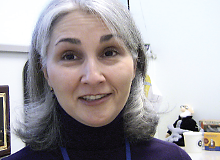Psychiatrist Finds Key to Teaching Psychodynamic Psychotherapy
Abstract
It turns out that psychodynamic psychotherapy, which has long been difficult to teach to psychiatry residents, can be taught in small concrete steps outlined in a manual.
In a snug office on the first floor of the New York State Psychiatric Institute in Manhattan can be found an energetic psychiatrist named Deborah Cabaniss, M.D.
If Sigmund Freud were alive, he would probably have the same smile on his face as the Sigmund Freud doll perched in Cabaniss’s office. For her passion—as director of psychotherapy training in the Department of Psychiatry at Columbia University—is kindling an enthusiasm for psychodynamic psychotherapy (PDP) in psychiatry residents and, even more crucially, teaching them how to do it.
A few years ago, the material that was available for teaching residents PDP was designed for psychoanalytic-training candidates and was very complex, Cabaniss said during a recent interview. And such material, she found, not only left residents bewildered, but often turned them off. At the same time, manuals for teaching residents newer evidence-based therapies such as cognitive-behavioral therapy were available. “I thought to myself, I want to have a book like that for PDP—a book that tells residents what the goals of the treatment are and how to do it, that provides exercises, and that helps educators teach the material in a very clear, straightforward way.”
So in 2007, with several colleagues, she set about creating such a syllabus. What they did, essentially, was take PDP and break it down into small concrete steps—listening, reflecting, and intervening. “First you listen to what the patient says. Then you reflect on what the patient said to decide what you are going to say. And then you intervene. And we teach each of these steps very specifically.”
Their residents, she and her colleagues observed, really liked this teaching method. And their residents started to say, “Well, my friend in California or Ohio wants the syllabus. Can we send it to him or her?” The answer was a book, published in 2011 and called PDP: A Clinical Manual.
Manual Gains Wide Acceptance

Deborah Cabaniss, M.D.: “If you teach clearly and in an operationalized way, you can teach psychodynamic psychotherapy in any part of a residency training program with any patient.”
Today the manual is being used in at least 25 of the approximately 200 psychiatry residency programs in the United States and Canada, as well as in psychology programs and at psychoanalytic institutes.
Last spring, Cabaniss and colleagues published a companion book to the manual called Psychodynamic Formulation.
A psychodynamic formulation is “a hypothesis about why someone thinks, feels, and behaves the way they do and how they developed,” she explained. “And that has been a very hard thing for people to teach residents. But using the methods we have, I think we are teaching it in a very straightforward way. Another aspect of the psychodynamic formulation book is that helps residents learn how to [use the] formulations in various types of clinical settings, not just in a private consultation room.”
Cabaniss has also been traveling a lot to help other residency programs strengthen their PDP teaching
Former Residents Value Her PDP Teaching
The real value of Cabaniss’s PDP teaching, however, can be gleaned from testimony provided by some of the residents she has taught and who are pursuing various types of psychiatry careers.
One is Catherine Roberts, M.D., who works in college mental health at Yale University. “Dr. Cabaniss’s teaching was hugely important in my training,” she stated. “To an unskilled, budding psychiatry resident in training, there was nothing more frustrating than hearing from a therapy supervisor, ‘Just use your instincts’ or ‘Go with your gut.’ This type of teaching wouldn’t be acceptable in a neurosurgery residency. Dr. Cabaniss made sure that it wasn’t acceptable either. Instead of leaving the practice of psychotherapy to ‘instinct,’ she made the different elements of psychotherapy concrete and explicit.”
“Dr. Cabaniss is one of the most talented and motivated teachers I have come across,” declared Sander Markx, M.D., who today works as a neuroscientist at Columbia University. “She was able to distill key concepts from often-complicated psychoanalytical constructs and theories and teach them in a manner that everyone could understand. I believe that this is a rare talent.”
Psychiatrist and psychoanalyst Alicia Rojas, M.D., said, “I think that Deborah’s enthusiasm for teaching PDP is infectious. She has a tremendous talent for making incredibly complicated obscure concepts accessible to the beginning therapist. She doesn’t just lecture, she engages students in dialogues. And her teaching is so full of clinical examples that it helps you take the principles she has taught you right into the consultation room.”
“Deborah has been wonderfully inspirational to me over the last five years, especially in helping me develop the way I teach psychiatry residents,” reported Lynn Corrin, M.D., a psychiatrist and newly appointed training analyst in San Diego. “Deborah’s ideas about establishing learning objectives first and then working backwards to develop a sequence of skills needed to be taught in order to meet those objectives has helped me conceptualize my teaching in a completely different way than I had earlier.”
Cabaniss might be viewed as the consummate PDP teacher, Deborah Hales, M.D., director of APA’s Division of Education, maintained. “She is smart, enthusiastic, and creative. She truly understands modern approaches to PDP.”
All in all, Cabaniss loves teaching PDP and hopes to do it indefinitely. “You can read in the New York Times that Freud is dead and that everybody just wants to take medications. But that is not what I see in my residents and in psychiatry residents throughout the country when I visit them. They are totally excited about PDP. They really get it. They understand how it will help their patients. And I find that absolutely thrilling!” ■
A video interview with Cabaniss can be accessed by going to http://www.youtube.com/watch?v=9xPhD-rB_cQ&list=UUAPLZ4LG-XJgNSB43MbCLRg&feature=c4-overview.



